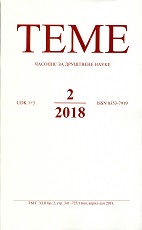Comparative Analysis of the Sustainable Development Indicators of the Western Balkan Countries and Certain EU Countries
Comparative Analysis of the Sustainable Development Indicators of the Western Balkan Countries and Certain EU Countries
Author(s): Jelena Trlaković, Danijela Despotović, Lela RistićSubject(s): International relations/trade, Socio-Economic Research
Published by: Универзитет у Нишу
Keywords: sustainable development indicators; Western Balkan countries (WBCs); European Union (EU)
Summary/Abstract: This paper aims to examine the sustainable development indicators of five Western Balkan countries (Albania, Bosnia and Herzegovina, Croatia, Macedonia and Serbia), which strategic objective, during the period 2000-2012, was to become part of the European Union (EU) and six countries (Bulgaria, the Czech Republic, Hungary, Poland, Slovakia and Slovenia), comparable according to certain indicators with the Western Balkan countries, which joined the EU with six other countries in the period from 2000 to 2012. Montenegro, as а WBC (Western Balkan country), is excluded from the analysis due to the lack of statistical data on the key indicators, while Croatia is assigned to the WBCs group since it joined the EU only in 2013. According to the Constitution of the Republic of Serbia, Kosovo is considered an integral part of the territory of the Republic of Serbia. This paper, therefore, covers 11 countries, which were divided into two groups. Sustainable development indicators were studied by taking into consideration the most important issues. The period from 2000 to 2012 was divided into three shorter periods in order to more precisely identify key changes. The period after 2012 is shown informatively and depending on availability of statistical data. Empirical analysis implies assessment of the sustainable development indicators through calculating their Spearman’s rank correlation coefficients. The paper consists of three sections. The first section introduces theoretical analysis of the concept and significance of sustainable development. In the second section, the analysis of sustainable development indicators based on the Eurostat methodology is performed; the available indicators for the WBCs were selected and analyzed in accordance with the mentioned methodology. The third section deals with the empirical analysis of the level of correlation between the WBCs sustainable development indicators and those of the EU Member States in relation to the EU average.
Journal: Teme - Časopis za Društvene Nauke
- Issue Year: XLII/2018
- Issue No: 2
- Page Range: 485-501
- Page Count: 17
- Language: English

